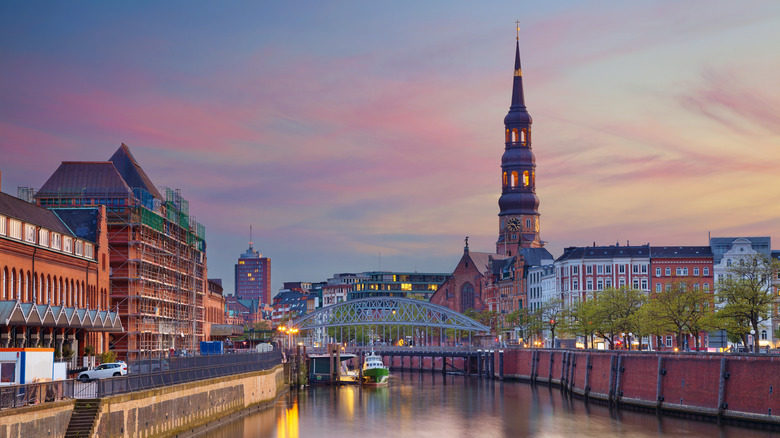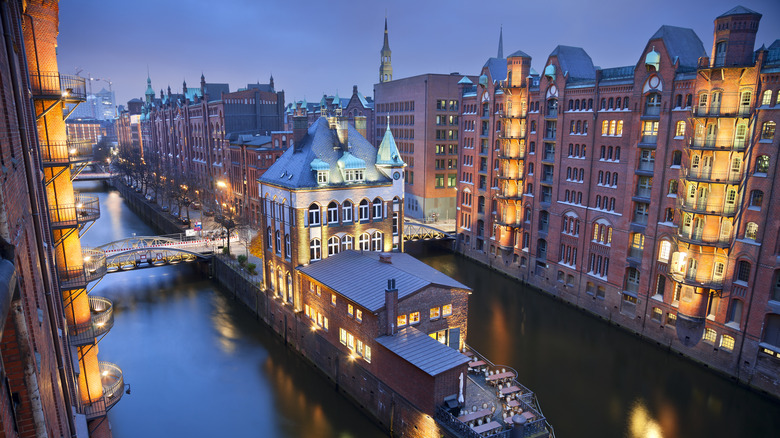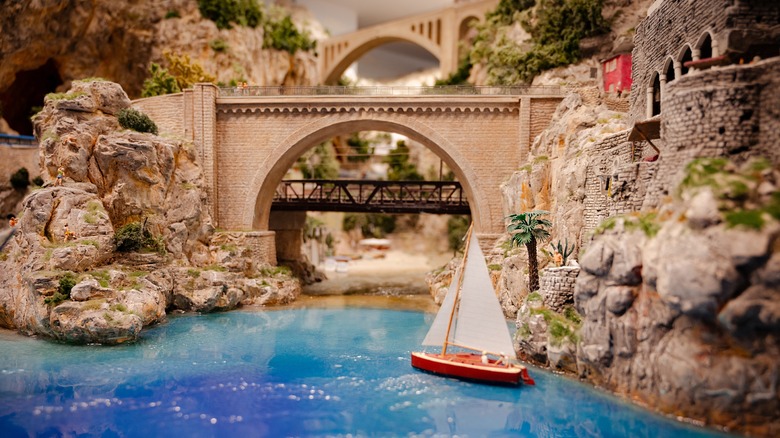The Underrated German City Known As The 'Venice Of The North' Has The Most Bridges In Europe
When daydreaming about European destinations to visit, you may consider London with its history and castles, Paris with its Eiffel Tower and the (overpriced) stores of Champs-Élysées, or the modern streets of Berlin. You might even think of the slowly sinking Venice, Italy, for its bridges and canals, despite the fact that the city charges tourists who only visit for the day. If the latter sparks something in your imagination, consider a beautiful and underrated alternative in Germany. Hamburg, in the north of the country, has more bridges than Venice and plenty of canals. In fact, it's been called the "Venice of the North."
Sitting around 60 miles from the North Sea, Hamburg features almost 2,500 bridges, with some from the modern era and one from as far back as the 17th century. It also has two manufactured lakes, Aussenalster and Binnenalster, which were formed in the Middle Ages following the damming of a river for a mill. You'll find many other attractions beyond the bridges in Hamburg, such as a miniature land, a modern concert hall complex, a town hall that survived a WWII bombing, and the lovely neighborhood of Speicherstadt.
The bridges of Hamburg, Germany
Hamburg boasts a wide variety of bridges, including Köhlbrandbrücke, the second-longest bridge in Germany. Inaugurated in 1974, this cable-stayed bridge between Speicherstadt and HafenCity is almost 2.5 miles long and about .2 miles wide. You can also walk across the Harburger Elbbrücke from 1899, which is a much shorter .3 miles long. These days, the pretty arched bridge caters solely to cyclists and pedestrians, so you can enjoy it at your leisure.
If you want to see a bridge that holds a record, check out the Kattwyk-Brücke, which spans just under .2 miles. The vertical lift bridge rises a bit over 150 feet, making it the largest vertical lift bridge in Germany. It lifts around every two hours, stopping vehicle traffic for between 15 and 20 minutes at a time, so keep that in mind if you plan on renting a car while in Europe and driving across it. The oldest bridge in the city, Zollenbrücke, comes in at 82 feet long with three arches. Though it hails from 1663, it has railing and lanterns from the 19th century.
Additionally, you can check out the small Trostbrücke from 1881 that crosses the Nikolaifleet. It has statues of Count Adolf III and Bishop Ansgar, the founder of the original cathedral in Hamburg. The bridge possesses a bit of an ominous past, despite its name translating to "comfort bridge," as prisoners traversed it on their way to trial.
Miniature World, the lakes, and Spiecherstadt
One unique spot in Hamburg is Miniatur Wunderland (pictured) in Speicherstadt. The spot, which contains over 260,000 miniatures, came about in 2000 and is a great destination if you have kids. It features tiny recreations of central Germany, Austria, Hamburg, places in the United States, Switzerland, Scandinavia, Venice, Rio de Janeiro, and more. Check out its model railway, the largest in the world. It took over 760,000 hours to create and has 130,000 trees. Admission for kids under 16 costs about $13.50, with adults paying around $21.50.
Elsewhere in Speicherstadt, in HafenCity, you'll find red brick buildings. It's a lovely place to walk or take a riverboat tour. It was once the largest port in Europe, though these days, it's number two after Rotterdam. You should also stop by Rathaus, the town hall that survived being bombed in WWII despite one landing in the center of the building (it didn't go off). It's also worth visiting the Elbphilharmonie, a concert hall, hotel, dwelling space, and public plaza where you can watch performances and take in the ambiance.
If you love the outdoors, go for a stroll by the city's two central lakes, Aussenalster and Binnenalster. It takes 15 minutes to go around the smaller of the two and over an hour for the other. You can also rent a canoe, paddle boat, or city bike to complete the circuit.


